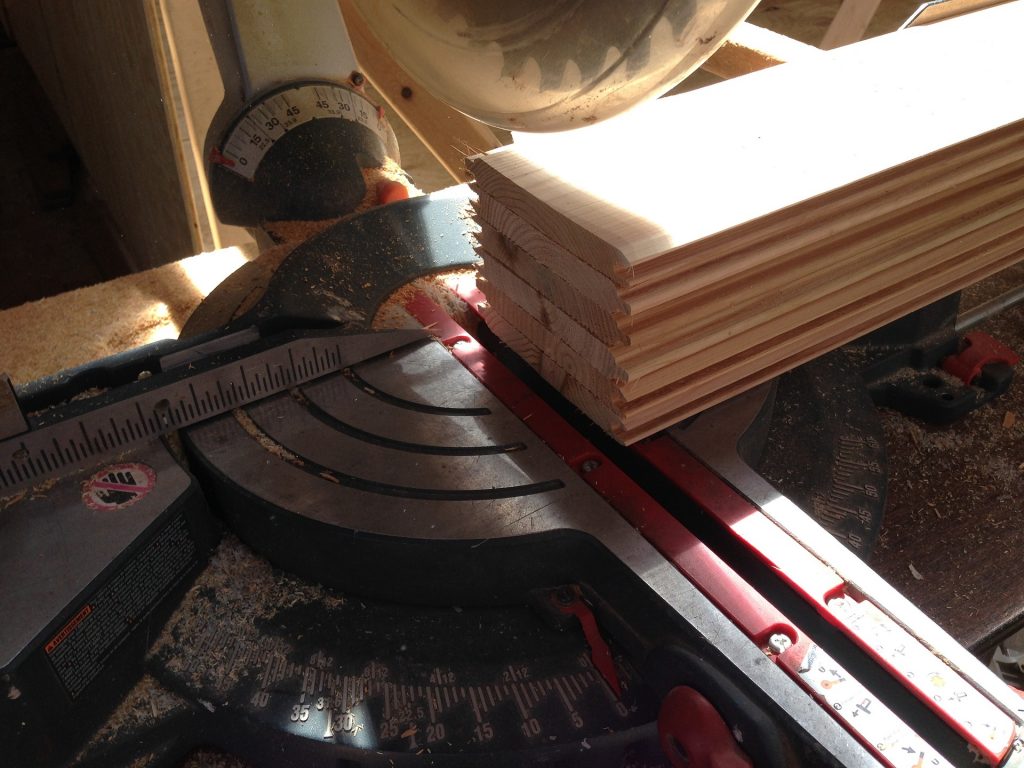Your miter saw can be knocked out of alignment for a number of different reasons.
This could be after continued use, due to transportation, due to cutting different types of materials, or even just by lying in storage. Some new miter saws are even shipped out with poor alignment.
If your miter saw is out of alignment, you don’t need to worry too much as you can square your miter saw yourself without professional help.
This post aims to detail all of the steps you need to take in order to ensure that your miter saw is perfectly squared.
So without further ado, let’s get into it.
Some Safety Tips
Before getting into the process of squaring your miter saw, it’s important to talk about safety:
- Make sure that your miter saw is unplugged before you start squaring it. Just powering it off is not enough, you need to unplug it. There have been reports of people getting electrocuted when handling their miter saw while it was plugged in.
- Make sure to use some sort of protective gloves.
- If you have long hair, be sure to tie them up.
- Don’t wear loose clothing.
- Be sure to work in an open space where you can easily handle the saw blade without bumping it into things.
- When cleaning up sawdust and debris, make sure to wear protective goggles to protect your eyes.
- When cleaning up sawdust and debris, make sure to wear a mask or some sort of respirator to ensure you’re not breathing it in.
How to Square Your Miter Saw Blade (Step-by-Step Guide)
Step 1: Cleaning the Miter Saw
Before you start aligning the miter saw, it’s important to clean both the saw as well as the work surface.
Cleaning up your saw and work surface is something you should be doing routinely.
However, if your saw happens to be knocked out of alignment, it’s a good idea to get rid of sawdust and other particles before you start squaring it.
Why Should I Clean My Miter Saw every time I use it?
If you haven’t already developed a habit of cleaning out your saw and work surface after every use, then this can be a good time to start.
This is important because pieces of dust and debris can impact the process of you aligning your saw. In fact, it very well could have been the cause of the misalignment in the first place.
An easy way to do this is to employ the use of an air compressor with an air nozzle on its hose’s end.
You can use this to blow away sawdust and other dust and debris from every part of your miter saw.
Once you have done this, take a clean cotton cloth and use it to wipe down the entirety of your miter saw.
Also, ensure that you take care of any pitch build-up that may have occurred.
Step 2: Checking the Blade
Before taking any steps to realign the blade or square the miter saw, it can be a good idea to just inspect the saw blade and see how it’s faring.
If it’s not clean, go ahead and clean it. If it’s become blunt, you will have to sharpen it first.
In case you encounter pitch build-up, you can use commercially available cleaners such as stain remover or Boeshield’s Rust to remove it.
Also, inspect your blade to examine its condition.
How to inspect my blade correctly?
Look out for any signs of warping. If it has too many broken teeth or has warped too much, be sure to replace your saw blade before beginning the process of alignment.
This is important because trying to align a miter saw blade that is warped can be highly difficult as the warping will interfere with the alignment process.
Simply swap out your warped miter saw blade with a new one before getting started with alignment.
Step 3: Table Alignment
If you have a miter saw, it will most likely be attached to either a working saw table or some other type of workbench.
Most work tables that people use for miter saws do not easily go out of alignment. That being said, extended use and old age can definitely knock them out of alignment from time to time.
Having an off-balance work table is highly dangerous and can interfere with most of your measurements. Hence, it’s very important that you align it at the earliest if it becomes misaligned.
How to align your Miter Saw?
To do this, simply place a straight edge on your work table and look at its measurements. If you notice that the level of the table is off, you can adjust it by sawing off a section of wood of one of the legs of the table.
On the other hand, you could also add a small wedge underneath one or more of your work table’s legs to make it level again too.
Important note: When you add a wedge underneath one or more legs of the table, ensure that the wedge is securely placed underneath it. You don’t want it to become dislodged while you’re working with an electrical saw as that can cause some serious accidents.
You don’t necessarily need a straight edge for this, you can kind of see it with your eyes too.
However, we would definitely recommend that you make use of a straight edge if you are able to.
Step 4: Fence Alignment
Once you’ve aligned your work table or workbench properly, the next thing you should be looking to align is the fence of your miter.
The fence refers to the back edge of your work table that is used for supporting long pieces of wood (or other materials) that you cut with the miter saw.
You can figure out if your fence requires alignment with the use of a straight edge.
How to align the fence of your miter?
Place the straight edge along your fence’s length and inspect its level for spots that are not squared.
If you find areas where it’s not squared, you can adjust the fence by loosening its screws, holding it in a position where it becomes squared, and then tightening the screws again.
Important note: Be sure to check and square both sides of your fence individually. This is because both sides won’t necessarily have the same alignment.
Step 5: Adjusting the Miter Angle
Now that you’ve cleaned your saw and your work surface, inspected the saw blade and leveled your work table, it’s time to adjust the miter saw angle.
The first thing you should do here is set your saw blade’s bevel angle to 0 degrees. After that, set the miter angle to 0 degrees as well.
The miter should square up perfectly with your fence.
Ensure that this is the case by using a combination square or rafter layout square. One of the edges of the square should be resting against the fence’s front edge.
Once this is done, lower your miter saw to its lowest possible position and slide the square into the blade’s side edge.
Note that in order to get access to the blade side, you may have to raise your miter saw’s blade guard.
At this point in the process, one edge of your combination square or rafter layout square should be positioned against the blade side while the other side should be resting securely against your fence.
Inspect the gaps between the blade and the fence to check if it’s even.
If you find any uneven gaps, you need to loosen the miter and tighten the knob. Adjust the miter angle until you reach the point where the blade and the fence are square to each other.
Step 6: Adjusting the Bevel Angle
Once the miter angle is done and dusted, the next thing you need to be looking towards is the bevel angle.
It does not matter if the bevel of your miter saw goes to 45 degrees only to the left or to both the right as well as the left.
The only thing you need to worry about here is that the table and the 0-degree angle of the bevel are at a square with each other.
Place your combination or rafter layout square on the edge with one of its edges facing upward from your table while the other edge is lying flat on it. Bring down the saw blade, ensuring that its blade guard is raised.
Move your square towards the blade until its vertically oriented edge and the saw blade become aligned with each other.
Inspect to ensure that there is not any gap between the square and the saw blade.
If you happen to find a gap, loosen the bevel adjustment knob and twist to adjust the bevel. Keep making adjustments until you close all gaps you find between the square and the saw blade.
Once you’re at an acceptable angle, tighten the knob to keep the bevel angle in place.
Step 7: Testing for Accuracy
Once you’ve successfully squared every part of your miter saw, it’s time to test its accuracy.
You can do this by simply turning your miter saw on and making cross-cuts at a 0 degrees miter angle on a wide wood piece.
Once you’ve made the cuts, check their accuracy by using a square or a level. If the cuts are not squared, you’ll have to repeat the steps described above.
Frequently Asked Questions (FAQs)
1. I Squared My Miter Saw but it’s Still Cutting Crooked. Why is This?
One major reason for this could be a bent saw blade.
Unplug your miter saw, take off its blade guard, and inspect the blade again. Do you notice any warping or bending? If so, then this is definitely the culprit.
Changing the miter saw blade will fix this issue.
2. How Much Do Miter Saws Typically Cost?
You can get a basic compound miter saw for as little as $100.
Miter saws with sliding blades start at $125 whereas dual-bevel miter saws start at $200.
Professional-level miter saws used by industry professionals can be priced as high as $800.
Wrapping Things Up…
With that, we’re at the end of our post detailing how you can square a miter saw.
We hope you have a better understanding of how to align your miter saw and how you can tell when it is not aligned.
Are there any common practices you have when aligning your miter saw? Let us know in the comments below.

